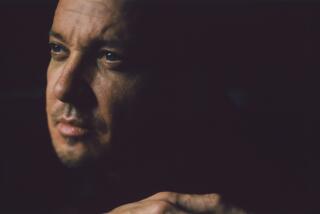A Wild Ride Through Fujita’s Sex and Violence
Sex and violence play such a big role in the movie industry that the last 50 years of film would be inconceivable without them. The same can’t be said about the visual arts.
For all kinds of reasons, painters have focused on other subjects, leaving the spectacle of these supposedly base impulses to lowbrow entertainments as high art strives to occupy the moral high ground.
Gajin Fujita has no patience with such sanctimonious shortsightedness. At L.A. Louver Gallery, his first solo show in Los Angeles embraces sex and violence as if they were going out of style. Marshaling the raw physical power of both subjects for his own purposes, Fujita, 30, uses them to stake out a place for himself--and anyone with similar sympathies--in an art world long dominated by lifeless abstractions and bloodless Conceptualism.
Eight eye-popping paintings fill two pristine galleries with visual punch and graphic drama. When you enter Fujita’s world you’re in for a wild ride. The centerpiece of the exhibition, “Gold State Warriors,” is a 5-foot-by-16-foot panel that depicts four sword-and gun-wielding samurai.
Strutting in front of a graffiti-covered wall whose brickwork consists of alternating squares of gold and silver leaf, the fierce warriors strike contorted poses that recall the formalized pantomime of Kabuki and the whiplash animation of Saturday-morning cartoons. Nearly lost in the Pop excitement is another distant ancestor: The lavender and blue kimonos worn by Fujita’s larger-than-life figures mimic the positions of the angled vertical forms in Jackson Pollock’s “Blue Poles,” whose allover energy generates a similarly dizzying charge.
“Dream” features an avenging angel about to decapitate a horned demon with fire-engine-red skin. His fleeing companion looks back with no remorse as L.A.’s skyline rises in the background like the silhouetted gravestones in an old cemetery. The graffiti that animates every square inch of this 8-foot-by-4-foot image consists of R.I.P. messages to friends who have died before their time, often in mindless street violence.
Fujita is a lot less ambivalent about sex than he is about violence. “La Damsel,” “Libido,” “Swell” and “Bangin’ ” combine the erotic acrobatics of traditional Japanese woodblock prints with the stylized forms of Edo screen painting and the lavish patterns of ornamental needlework. The explicit positions of the figures in these variously scaled paintings, which measure from 8 inches to 8 feet on a side, fit right in with the bold designs and graphic flourishes that are Fujita’s forte.
He’s at his best when he turns words into quasi-architectural supports for decorative embellishments. Delicate flowers, puffy clouds, graceful birds and waves made of curlicues are integral to his vibrant pictures.
So is color, which he deploys like a pyromaniac in charge of a fireworks display.
When words made their way into contemporary art, they had all the visual dynamism of typewritten messages. Fujita makes playful fun of such image-and-text Conceptualism, turning its tactics into a form of rowdy street theater whose pleasures are all the more potent for being riddled with risk.
L.A. Louver Gallery, 45 N. Venice Blvd., (310) 822-4955, through Oct. 12. Closed Sundays and Mondays.
*
Leni Riefenstahl: Grace and Beauty in Africa
The specter of Fascism still looms over the storied career of Leni Riefenstahl. Born in 1902, she began her professional life as a ballet dancer in Berlin in the early 1920s and then made a name for herself as a silent-movie actress. International renown was hers at 32, when she was commissioned to direct her most famous film, “Triumph of the Will.” So was Hitler’s stamp of approval, when the Nazi party used her groundbreaking documentary as a propaganda tool.
Infamy followed. Unlike some Third Reich scientists, who came to the United States after the war and started quietly working for the government, Riefenstahl couldn’t escape moral disdain. As is often the case, art was a lightning rod. Her career came to a screeching halt.
She disappeared from public view, turned her attention to still photography and took to traveling far off the beaten path, taking pictures of people and places whose pasts were nothing like hers. At 72, she learned to scuba dive and began making underwater photographs and videos. Today Riefenstahl, 100, lives in Germany, where she is happy to see that her life’s work is beginning to be seen in its own right.
At Fahey/Klein Gallery, 30 color photographs she made between 1962 and 1977 in a remote mountain valley in the Sudanese province of Kordofan go a long way to show that there’s nothing intrinsically fascistic about Riefenstahl’s art. Her stunning pictures of the Nuba and Kau peoples reveal her to be a connoisseur of the grace, beauty and strength of the human body--particularly when it’s stripped nearly naked, all the better to show off its physical magnificence and sexy athleticism.
The majority of the images in Riefenstahl’s second solo show in North America are dye transfer prints whose lush colors capture the stark sensuality and mirage-like shimmer of Saharan sunlight. All but a few depict Kau men, women and children who live in the villages of Nyaro and Fungor.
Riefenstahl doesn’t mess around with the mundane. Every square inch of every photograph is calibrated to heighten its dramatic impact.
When the men are not fighting ritualized battles with knives strapped to their wrists, guarding villages with spears or attending burial ceremonies covered in ash, they’re seen in close-up. Riefenstahl’s portraits feature young men whose handsome faces are painted in elaborate patterns with organic pigments. Feathers and seedpods accentuate their close-cropped hair. Gold jewelry adds a regal touch, and scarred foreheads never let you forget that power and pain are inseparable parts of prestige. Necklaces, bracelets and belts, as well as their hairdos and painstakingly scarred midriffs, make the men’s decorations look streamlined, like a Minimalist version of Cubism.
Riefenstahl’s pictures of women are even more riveting. Many are full-length portraits of lithe girls performing ecstatic dances, their naked bodies coated with oil.
The remaining photographs depict the more placid Mesakin Quissayr Nuba, whose rituals are less bloody but no less fascinating. Riefenstahl’s distant shots of rocky mountainsides, dry fields and dusty villages are equally otherworldly.
Although these photographs document ways of life that have all but disappeared in the 21st century, it’s important to remember that Riefenstahl is neither an anthropologist nor a tourist, but an artist--an old-fashioned Romantic, whose quest for beauty has taken her to the far ends of the Earth.
Fahey/Klein Gallery, 148 N. La Brea Ave., L.A., (323) 934-2250, through Oct. 19. Closed Mondays.
*
Crystalline Photos Evoke Ancient Roman Opulence
Eleanor Antin’s mural-scale photographs at Craig Krull Gallery are not remarkable because of what they depict--scenes of debauchery and decadence on the cusp of the apocalypse--but because of how they do so: with such a queasy combination of over-the-top artifice and too-good-to-be-true Realism that you can’t be sure you’re not hallucinating.
Titled “The Last Days of Pompeii,” Antin’s crystalline images feature toga-clad folks idling away seemingly endless summer afternoons at a fabulously manicured estate in Rancho Santa Fe. For all its rose gardens, sweeping vistas, spacious patios and vaguely classical colonnades, the luxurious residence might as well be a movie set for an old-fashioned costume drama or an 18th century salon painting of Roman opulence and lassitude.
In one, the muscular bodies of two male wrestlers glisten in the sunlight as eight pretty women lounge around in the grass. Some are too bored to be bothered, but others look on intently, their world-weary expressions alive with lasciviousness.
In another color-saturated photograph, two brawny gladiators barely get the attention of their reclining audience, despite battling to the death. In a third, five inhabitants appear to have been buried alive by a shower of gold coins.
In a fourth, six beautiful women wrap themselves around an old tree’s serpentine branches. All stare, with mildly curious expressions and general cluelessness, at an unconscious woman lying on the ground. Although she appears to have fallen out of the tree, no one above budges from her perch.
Antin’s photographs stick in the mind’s eye because of their unbelievable clarity and the sumptuous light that spills from their surfaces. So crisp and vivid are so many of the figures’ outlines that you have to go up close to convince yourself that they’re not collaged on or added via a computer’s digital tricks. Taking a cue from the Pageant of Masters, the San Diego-based artist’s pictures tell some big truths by telling many little lies.
Craig Krull Gallery, 2525 Michigan Ave., Bergamot Station, Santa Monica, (310) 828-6410, through Oct. 12. Closed Mondays.
*
Playing Color Against Expanses of Blankness
Philip Argent’s new paintings are so far ahead of the curve that you have to be pretty sophisticated to know just how good they are. Artists generally recognize what the Santa Barbara-based painter is up to. As his sexy lexicon of color, shape and texture trickles into their work, the viewing public will become more familiar with Argent’s innovations and recognize his importance.
For now, his oddly formatted abstractions are so suave and seductive that it’s easy to disregard their formal toughness and the vertiginous twists and turns they serve up with seemingly effortless ease. The main room at Shoshana Wayne Gallery is a monster of a space. More suited to sculpture than painting, its cavernous dimensions swallow up all but the strongest of two-dimensional works. Argent’s seven acrylics on canvas command the space so gracefully that its empty areas even feed into the brightly colored shapes and razor-sharp lines he has laid out across the velvety smooth surfaces of his rolled, brushed and sprayed paintings.
Argent uses empty space better than any other painter working today. Large expanses of cool whiteness cover more than half of each canvas. These blank, squeaky-clean fields provide the eye with places to rest amid the sweeping motions set up by the rest of his compositions, which include ricocheting lines, warped windows and sliced stripes, cartoon explosions, atmospheres choked with smoke and blurry flourishes that look like rainbows made of Naugahyde.
Argent’s palette starts where Lari Pittman’s and Howard Arkley’s leave off--in a world of weirdly beautiful tertiary colors that would be ugly in the hands of lesser talents. A leader among fellow sci-fi futurists Adam Ross, Stephen Herr, Dimitri Kozyrev and Bart Exposito, Argent makes up-to-the-minute computer graphics look like yesterday’s news.
Shoshana Wayne Gallery, 2525 Michigan Ave., Bergamot Station, (310) 453-7535, through Oct. 16. Closed Sundays and Mondays.
More to Read
The biggest entertainment stories
Get our big stories about Hollywood, film, television, music, arts, culture and more right in your inbox as soon as they publish.
You may occasionally receive promotional content from the Los Angeles Times.






